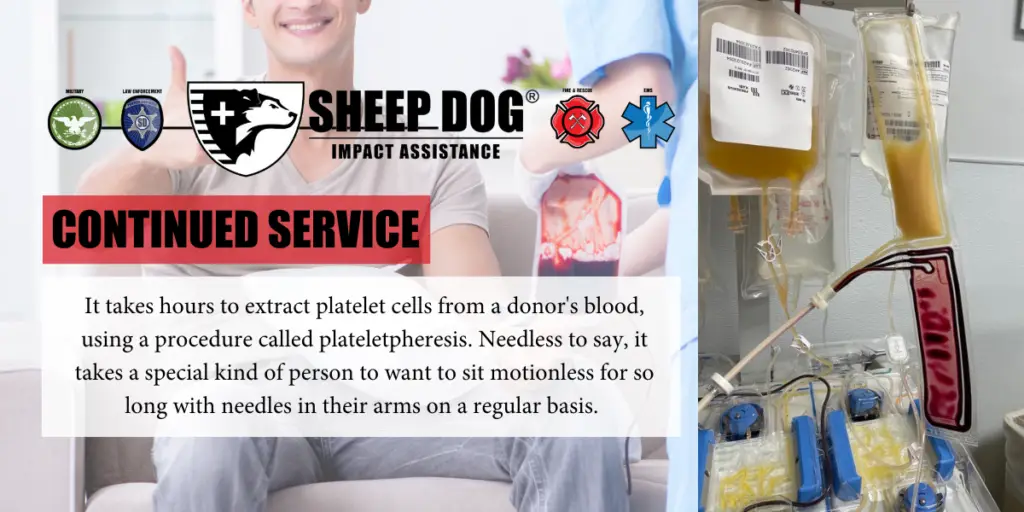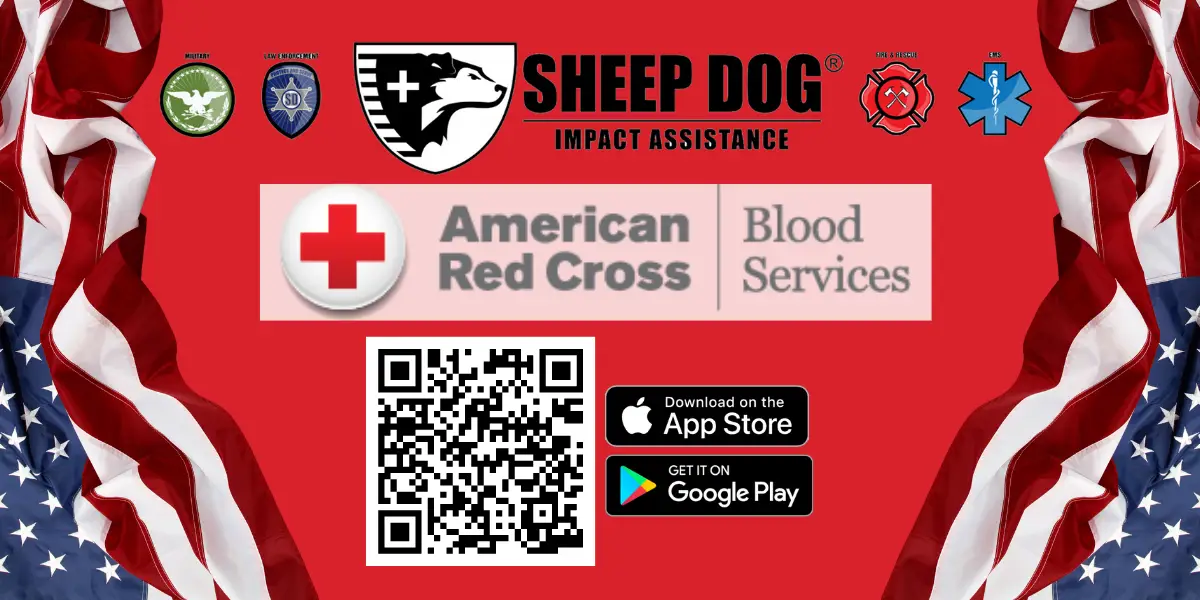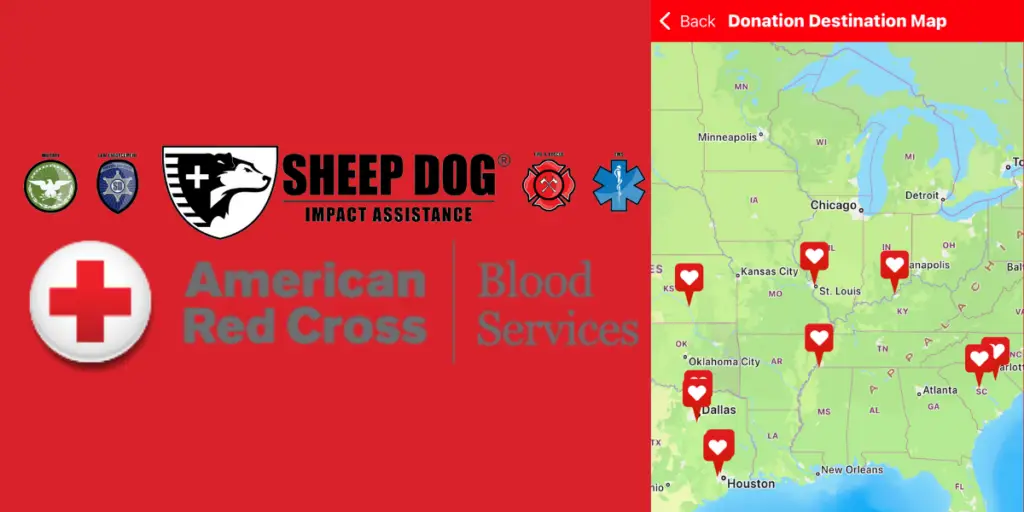Sheep Dog Blood Donor Team Rises to Top 100 Thanks to Elite Givers
Making it to the top 100 of over 64,000 teams isn’t easy in any competition—that is, unless you truly have the best of the best in your ranks.
The competition: Who can give the most blood?
The competitors: All kinds of organizations from across the nation.
The prize? Some would say giving blood is its prize, knowing a stranger somewhere now has a better chance at life.
According to Brett Crystal, a Red Cross staffer, the grand tournament has been ongoing in the Red Cross Blood App for about a decade. Individual donors can form teams to represent their chosen cause or organization with their blood donations.
Without donated blood products, countless lives would be cut short every single day. This fact hits close to home with Sheep Dog Impact Assistance. Scott West, Sheep Dog’s Director of Outdoor Adventures, once depended on blood transfusions to survive. He suffered the loss of both legs in an explosion while serving as a Cavalry Scout in Iraq. In a voice interview, West recalled, “I lost 45% of my blood. I wouldn’t be here if it weren’t for the medics and blood transfusions, both in Iraq and in the hospital in Germany.”
Dozens of surgeries and a few years later, Scott West was jumping out of airplanes again. He now tells his incredible story and leads our nation’s Sheep Dogs through rigorous outdoor experiences to give them a fresh perspective on their lives.
Sometime after the American Red Cross decided to launch the friendly competition in 2014, an anonymous supporter took the initiative and started a small team called “Sheep Dog Impact Assistance.” With a membership of three, they impacted some lives and rose to about the median in the team ranking, placing 29,900 out of 63,000 teams.
But in February 2024, an elite kind of blood donor responded to a team recruitment call on social media. Upon learning of Sheep Dog’s cause of Post-Traumatic Growth to prevent suicide in the military and first responder communities, Jim Henderson decided to take a stand with the team. But Jim isn’t just any blood donor. He is a Plateleteer. And he brought Plateleteer friends.
‘Plateleteer’ is the affectionate moniker of those who hail from the platelet donor community. It is a community that wields incredible power for the good of humanity.
In a Facebook comment, Henderson said, “I was aware that there is a problem but was not aware of the name of your organization. So let’s see if we can get a few folks to help in changing that awareness.”
In the span of three days, Sheep Dog’s blood donor team skyrocketed in rank, all the way up to 76th place out of 64,400 teams. Team Sheep Dog shot ahead of such names as “Ford Motor Company,” “Kansas City Chiefs,” “Rotary International,” “U.S. Army,” and “U.S. Navy.” But while these other teams have hundreds of members, Sheep Dog’s only has 17. How have these 17 people out-donated other, bigger teams hundreds to one and impacted 19,000 lives?
Platelets: Unlike whole blood, which can only be given about every two months, platelets can be given multiple units at a time, up to 24 times per year. Some donors, like Julie Schaller and Jeneen Boudrie, often give three units of platelets and one of plasma in a sitting. When those two joined Sheep Dog’s team, the impact score increased by thousands of lives. Boudrie said, “If I could help our veterans and first responders, even as little as it may be, I would like to do what I can. My sister-in-law was dispatch… I have the utmost respect for our first responders and service men and women.”
Platelets are the blood component that ensures proper clotting so bleeding stops. Their shelf life is short, and they are not easy to get. According to Brett Crystal, Social Media Associate and administrator of the Platelet Donor Facebook group, “Every 15 seconds someone needs platelets…there is a constant, often critical, need for new and current donors to give to keep up with hospital demand.” He also noted that Red Cross is at a 5-year low for platelet donors.
It takes hours to extract platelet cells from a donor’s blood, using a procedure called plateletpheresis. Needless to say, it takes a special kind of person to want to sit motionless for so long with needles in their arms on a regular basis.

Thankfully, those people do exist, and they have an admirable dedication to their altruistic mission. A few have embraced this giving as part of their lifestyle and have donated for decades.
Bob Hungerschafer started giving platelets at age 16 in 1973. Now, half a century later, he has given 2,827 units (considered equivalent to 353 gallons). He may be the top donor his age in the world.
The son of a soldier, Hungerschafer chose to use his incredible record of sacrifice to point to the plight of veterans and first responders who have suffered trauma. “This is a worthy cause,” said Hungerschafer, “Not many people have to see the type of things they do. Some don’t get over it.”
When Jim, Bob, Brett, Julie, Jeneen, and a few others like them joined the team, their exponential impact illustrated just how special a thing it is to make plateletpheresis a part of your routine. They also showed in a real way how much they appreciate the service of first responders and the military.
Service to others is a proven way to find healing and freedom from past trauma. Regular platelet donation is one great example of Continued Service. If you have a desire to try something different and help a stranger in need, maybe it’s time to Get Off The Couch and into a donation chair!
Anyone who would like to join Sheep Dog’s blood donation team to keep the momentum going can tap this this link on their smartphone. Whether you have given blood many times or never before at all, there is no time like the present to step forward.
Let’s go for top 10!
At this time, the team “Sheep Dog Impact Assistance” is an unofficial and casual nod to SDIA within the Red Cross Blood App. We believe that if SDIA continued to develop their plateleteer team, our team could realistically rank in the top 5 of all blood donation teams. Our team would have to donate enough units to impact 240,000 lives, which is not a far reach, considering that we went from 10 to 18,000 just by adding a few highly dedicated members. This would place SDIA just below the impact of the Church of Jesus Christ of Latter-Day Saints and the Boy Scouts of America. More importantly, by raising awareness mutually with platelets and PTG, other organizations may join or renew efforts in the competition to rank higher amongst the teams. It could have an incredibly positive domino effect with the potential to solve a critical public health concern of the near future. Finally, and of great consequence, is the consideration of the individual life trajectory of the Sheep Dogs who choose to become plateleteers. One Sheep Dog Member states, “I can attest that it has added a whole dimension of purpose to my existence. I am at the 1 gallon mark myself, and I look forward to my 10-gallon milestone.”
Quick facts:
- Platelets are a blood product not to be confused with plasma. Plasma donors are typically compensated through a cash reward system for their donation. Financial gain is a common motivation for plasma donors. Platelet donors are not compensated (though they may receive modest vendor gift card codes and point-system promotional items). Platelet donation is far more altruistic than typical plasma donation.
- Platelets have a 5-day shelf life and are an essential blood component to preserve the lives of cancer patients and trauma victims. Platelet deficiency can result in death by hemorrhage.
- Platelet donors, known as “Plateleteers,” have a unique subculture. Because an individual can donate weekly or every other week, up to 24 times per year, it becomes a significant and positive part of the lifestyle of the donor.
- There is currently a critical shortage and a deficit of scheduled donations. With an aging population of Baby Boomers who have long championed blood product donation, a public health crisis could be imminent if something does not change.
- The monetary value of one unit of platelets is approximately $500 toward Red Cross operating costs. If thought of as an in-kind donation, a regular plateleteer gives up to $24,000 worth of platelets annually to the Red Cross without costing the donor anything financially.
- Platelet collection (plateletpheresis) takes over 2 hours, with video streaming services available to the donor during that time.
- Platelet drives are not customary, however, individual donation appointments can be scheduled days or months in advance.
- There is a Red Cross Platelet collection center in Springfield Missouri (1.5 hours from Heroes Ranch).
SDIA’s foundation and ongoing commitment to Continued Service revolve around disaster response, serving as a primary avenue for our Get Off The Couch® programming. These missions, a key component of our volunteerism, empower our Sheep Dogs to consistently contribute to their communities and country in times of need.

